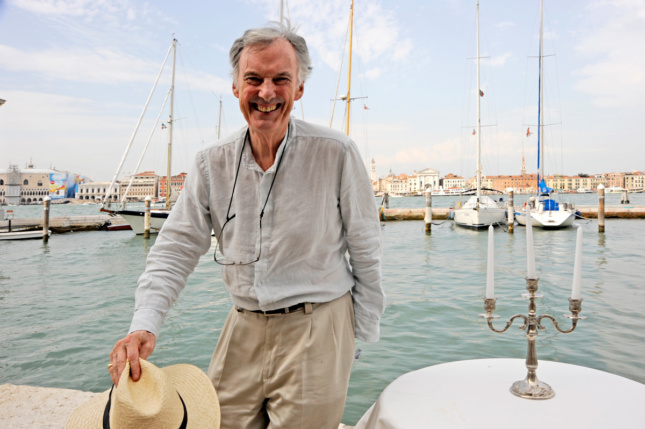Provocateur, philosopher, and polymath Charles Jencks had a kaleidoscopic perspective on the forces and complexities of the cosmos. From his student days onward he was voracious in his interests, explorations, and speculations. At Harvard’s Graduate School of Design, he cut a swath with his precocious wit, preternatural eloquence, and confident banter. He was lanky, elegant, and a bit of a dandy and knew how to provoke, entertain, and charm.
Charles never gave a lecture, led a symposium, or even held forth over lunch without changing the magnetic field forces of the space. He was a passionate teacher; powerful because he both provoked his students and invited them to jump into the scrum of debate. Once they learned that he liked nothing better than to be challenged, the whole world of analytic and critical thinking opened up to them. The force of his personality and power of his intellect was leavened by his wit, warmth, and occasional self-deprecation.
Charles was determined to bridge theory and practice. He made his mark early with polemic and influential books. But wherever possible he sought to test his theoretical propositions with material challenges in situ. He used a series of small but densely composed projects to posit, test, and expand his thinking. This began with the Garagia Rotunda, a modest studio at his family’s beach house in Wellfleet on Cape Cod, where he explored the use and improvisatory opportunities of readymade components. Next, the Elemental House in Rustic Canyon, Santa Monica, California, riffed on and reworked a 1950s western ranch house while celebrating the elements of earth, air, water, and fire. He reached an epiphany of embodied symbolism with the Thematic House in London where the cycles of seasons, sun, and moon are celebrated.
He often invited friends to collaborate. Terry Farrell collaborated on the Thematic House, where Michael Graves contributed to the Winter Room. Over several years Tina Beebe and I had the pleasure of collaborating with Charlie and his wife Maggie Keswick Jencks on two houses. I worked with Charlie and Maggie on the planning and architecture of the Elemental House, where Tina worked on the color and materials and Maggie led the garden design. Charles Moore contributed to the Water Pavilion. Tina then worked with Jencks and Maggie on colors and material for the London house.
For Charles, all aspects of his work and life were integrated. Whether home or traveling, he was constantly writing, sketching, and testing ideas with undiminished enthusiasm and unrelenting purpose. Most of our design meetings were set at home and coordinated with drinks and meals. When in Los Angeles (where he taught at UCLA), he and Maggie hosted convivial Sunday lunches on their terrace and delighted in convening old and new friends with the most diverse interests possible. It was all part of connecting the dots and mysterious forces of the cosmos.
Charles savored debate, spanning from the Socratic to the operatic. He valued disruption long before it became a meme of the tech and business worlds. And if one was reticent to partake, he would tempt and taunt until ignition was achieved. Maggie was his great muse but often an important counterpoint, as well. Tina remembers a particularly robust debate in London. Charles was making the point that every aspect and every detail of the house had to be infused with meaning. Maggie and Tina were arguing that sometimes the meaning is inherent in the experience and does not need to be literally described. As the debate got more heated, these two strong women achieved a standoff with Charlie—not an easy feat, even when double teaming. Finally, exasperated, he exclaimed: “I don’t care what it means, as long as it means something!” After a brief pause, the argument was defused over drinks and all was commodious again.
Maggie also bridged theory and practice. Her poetically written book The Chinese Garden: History, Art and Architecture helped to establish the foundation for her work as a landscape designer both for herself and for commissions. At the Elemental House, she was inspired by John Milton’s poems L’Allegro and Il Penseroso, creating an imaginative garden that embodied the dualities of joy and contemplation.
This partnership between Maggie’s deep understanding of the landscape and Charlie’s evolving interest in the forces and symbols of the cosmos reached new heights in their collaboration on The Garden of Cosmic Speculation at Portrack, their country house near Dumfries, Scotland. This veritable gesamtkunstwerk was organized as a cosmic narrative, which one experiences through a compelling landscape sequence and metaphoric meander through the Quark Walk, the DNA Garden, the Fractal Terrace, and other cosmic phenomena. This was a seminal work that inspired the next phase of his exploration.
The project unified art, architecture, and landscape, creating environments of great lyric and choreographic beauty. It was informed and structured by theory but animated by the experiential delight of its forms and materials. The work at Portrack became the basis for a fecund new period in Charlie’s creative life. He continued his writing and teaching, but increasingly focused on a new body of commissioned landforms for museums and sites around the world.
The Jencks’ wonderful daughter Lily became a collaborator and continues to lecture and design at the intersection of landscape, art, and architecture.
In parallel, Jencks curated the architecture of some 22 Maggie’s Centres. Designed by eminent architects, these spaces provide healing environments and supportive care for cancer patients. They are based on Maggie’s belief that people should “not lose the joy of living in the fear of dying.”
As I think of Charlie, I imagine him now fully engaged in the cosmos, extending his insatiable curiosity and deep understanding into all the forces and cycles of life.
Buzz Yudell was a friend and collaborator of Charles Jencks. He is a partner at the Santa Monica-based firm Moor Ruble Yudell Architects & Planners.
